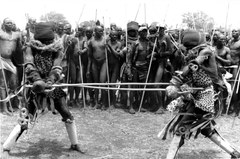Pole fighting (donga)
The duelling weapon is a wooden pole (donga, pl. dongen), around two meters long which is cut from one of two species of tree of the genus Grewia (kalochi). In the attacking position the donga is gripped at its base with both hands, the left above the right, the aim being to land a blow with the shaft (never with the point) on any part of the opponent’s body, including the head, with sufficient force to knock him over. Blows are parried by continuing to grip the base of the donga with the right hand, while sliding the left hand up the shaft to a point above that at which the blow is received. Each contestant wears a duelling 'kit' (tumoga) which is both protective and decorative. It includes a basket-work hand guard for the right hand, shin guards made from animal skin, rings of plaited sisal cord to protect the elbows and knees, a leopard skin over the front of the torso, a hide skirt, cut into strips, and a cattle bell tied round the waist. The head is protected by wrapping round it long swathes of cotton cloth. Bouts are controlled by one or more referees (kwethana, sing. kwethani).
The duelling weapon is a wooden pole (donga, pl. dongen), around two meters long which is cut from one of two species of tree of the genus Grewia (kalochi). In the attacking position the donga is gripped at its base with both hands, the left above the right, the aim being to land a blow with the shaft (never with the point) on any part of the opponent’s body, including the head, with sufficient force to knock him over. Blows are parried by continuing to grip the base of the donga with the right hand, while sliding the left hand up the shaft to a point above that at which the blow is received. Each contestant wears a duelling 'kit' (tumoga) which is both protective and decorative. It includes a basket-work hand guard for the right hand, shin guards made from animal skin, rings of plaited sisal cord to protect the elbows and knees, a leopard skin over the front of the torso, a hide skirt, cut into strips, and a cattle bell tied round the waist. The head is protected by wrapping round it long swathes of cotton cloth. Bouts are controlled by one or more referees (kwethana, sing. kwethani).
For a bout to end in the victory of one of the contestants, his opponent must either fall to the ground or retire hurt (commonly because of broken or bruised fingers). In the first case, though not in the second, the victor is carried round the field on the shoulders of his local age mates and then surrounded by unmarried girls of his mother's clan, his ‘girl mothers’ (dole juge). They lay goat skins on the ground for him to sit on and hold cotton cloth above him, stretched on duelling poles, to provide shade. The explicit symbolism here is that of a mother protecting her baby from the sun: 'They are wrapping up their child. Doesn't one wrap up a baby to protect it from the sun?' It is probably this custom which gave rise to the popular misconception that the victor in a duelling contest can take his pick of the available marriageable girls. In fact, there is a strict prohibition on marriage between a man and a woman of his mother’s clan. It is these same 'girl mothers' who welcome a man back from war, after he has killed for the first time, with gifts of necklace beads.
A duelling contest usually takes place over several days and is carefully prepared for, often being discussed, within and between both contesting groups, for several months in advance. It is scheduled for a time of year when there is plenty of food available, so that the participants can be physically well prepared. When it eventually takes place, it is treated with the utmost seriousness, one indication of this being that it is frequently described as ‘war’ (kaman). And like war, duelling contests are not seen as isolated or ‘one off’ events. They are seen as part of a continuing series of events, in which each side takes it in turn to visit the other side’s ‘home ground’, at intervals of up to a year, to ‘exchange’ their ‘wounds’ (chacha muloi).
More information
Jon Abbink, ‘Violence Ritual and Reproduction: Culture and Context in Surma Dueling’, Ethnology, 38 1999, pp. 227-242.
David Turton, ‘The same only different: war and duelling as boundary marking rituals in Mursiland, southwestern Ethiopia’, in: T. J. Cornell and T.B. Allen (eds.) War and Games, Boydell Press, Woodbridge, Suffolk 2002, 171-92.
Tamas Regi, 'Mursi Duelling: a photo essay'


